Creativity, Innovation and Design Thinking in Organizations
VerifiedAdded on 2022/08/22
|10
|2489
|17
Essay
AI Summary
This essay analyzes the impact of organizations on strengthening creativity, innovation, and design thinking processes, arguing against the notion that these are solely dependent on individual employees. The essay begins by defining key terms: creativity as a driver for growth and innovation, innovation as the implementation of creative ideas, and design thinking as a user-centered approach to problem-solving. It then explores the roles of individual traits, organizational policies, and strategies in fostering these elements. The essay presents a model of individual creativity and highlights the influence of factors such as self-motivation, risk orientation, and diverse experiences. It also examines the Google Corporation case study, emphasizing how Google's policies, including its communication of a clear vision, 20% time policy, TGIF meetings, employee welfare, and 10X thinking, contribute to a culture of innovation. Furthermore, the essay discusses a model of organizational innovation, emphasizing the interaction of techniques, resources, and motivation to strengthen creativity. The conclusion partially disagrees with the statement, asserting that while individual creativity is important, organizations play a crucial role in shaping the environment to foster innovation and design thinking, which, in turn, impacts competitive advantage. The essay uses several references to support the arguments.
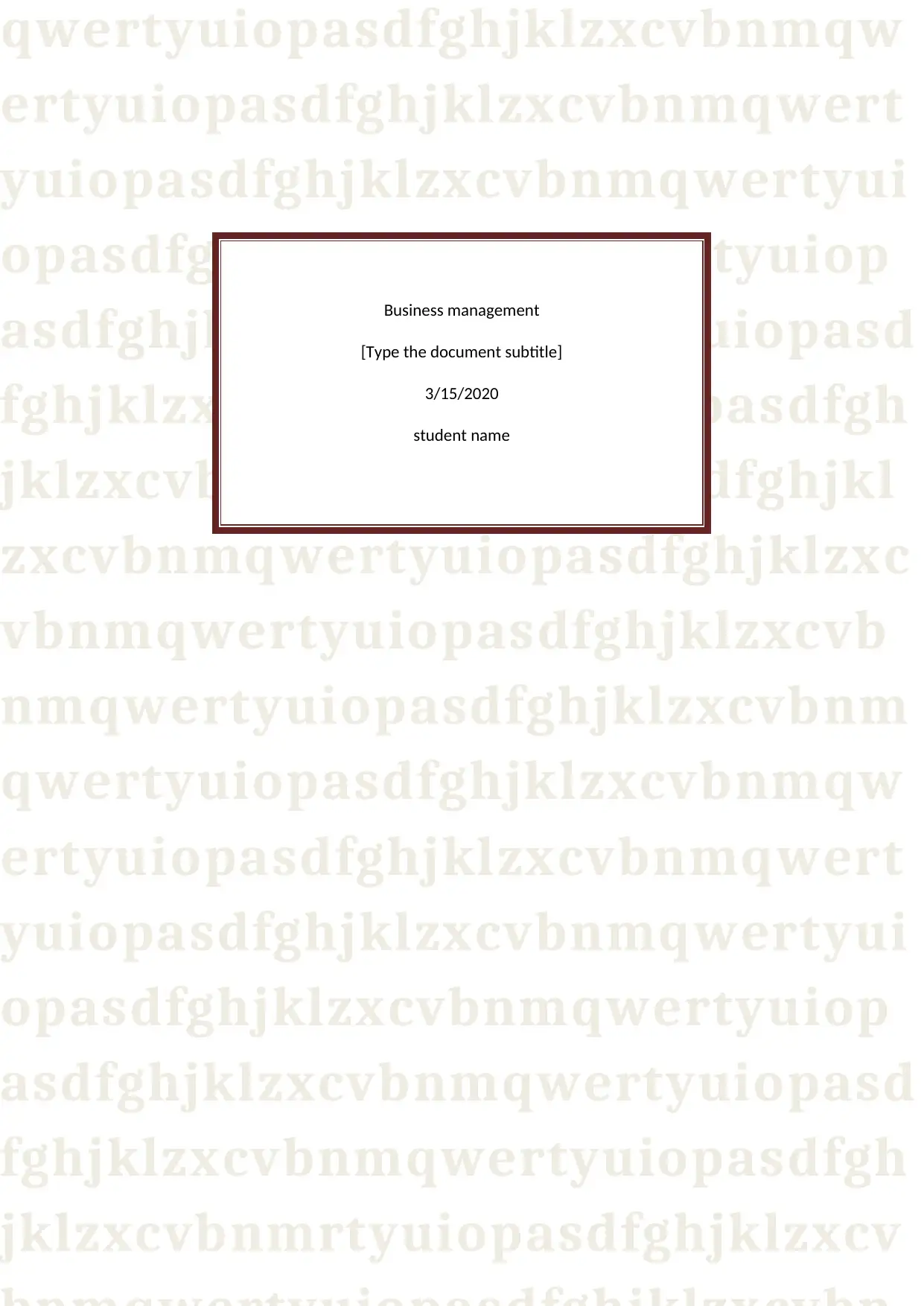
qwertyuiopasdfghjklzxcvbnmqw
ertyuiopasdfghjklzxcvbnmqwert
yuiopasdfghjklzxcvbnmqwertyui
opasdfghjklzxcvbnmqwertyuiop
asdfghjklzxcvbnmqwertyuiopasd
fghjklzxcvbnmqwertyuiopasdfgh
jklzxcvbnmqwertyuiopasdfghjkl
zxcvbnmqwertyuiopasdfghjklzxc
vbnmqwertyuiopasdfghjklzxcvb
nmqwertyuiopasdfghjklzxcvbnm
qwertyuiopasdfghjklzxcvbnmqw
ertyuiopasdfghjklzxcvbnmqwert
yuiopasdfghjklzxcvbnmqwertyui
opasdfghjklzxcvbnmqwertyuiop
asdfghjklzxcvbnmqwertyuiopasd
fghjklzxcvbnmqwertyuiopasdfgh
jklzxcvbnmrtyuiopasdfghjklzxcv
Business management
[Type the document subtitle]
3/15/2020
student name
ertyuiopasdfghjklzxcvbnmqwert
yuiopasdfghjklzxcvbnmqwertyui
opasdfghjklzxcvbnmqwertyuiop
asdfghjklzxcvbnmqwertyuiopasd
fghjklzxcvbnmqwertyuiopasdfgh
jklzxcvbnmqwertyuiopasdfghjkl
zxcvbnmqwertyuiopasdfghjklzxc
vbnmqwertyuiopasdfghjklzxcvb
nmqwertyuiopasdfghjklzxcvbnm
qwertyuiopasdfghjklzxcvbnmqw
ertyuiopasdfghjklzxcvbnmqwert
yuiopasdfghjklzxcvbnmqwertyui
opasdfghjklzxcvbnmqwertyuiop
asdfghjklzxcvbnmqwertyuiopasd
fghjklzxcvbnmqwertyuiopasdfgh
jklzxcvbnmrtyuiopasdfghjklzxcv
Business management
[Type the document subtitle]
3/15/2020
student name
Paraphrase This Document
Need a fresh take? Get an instant paraphrase of this document with our AI Paraphraser
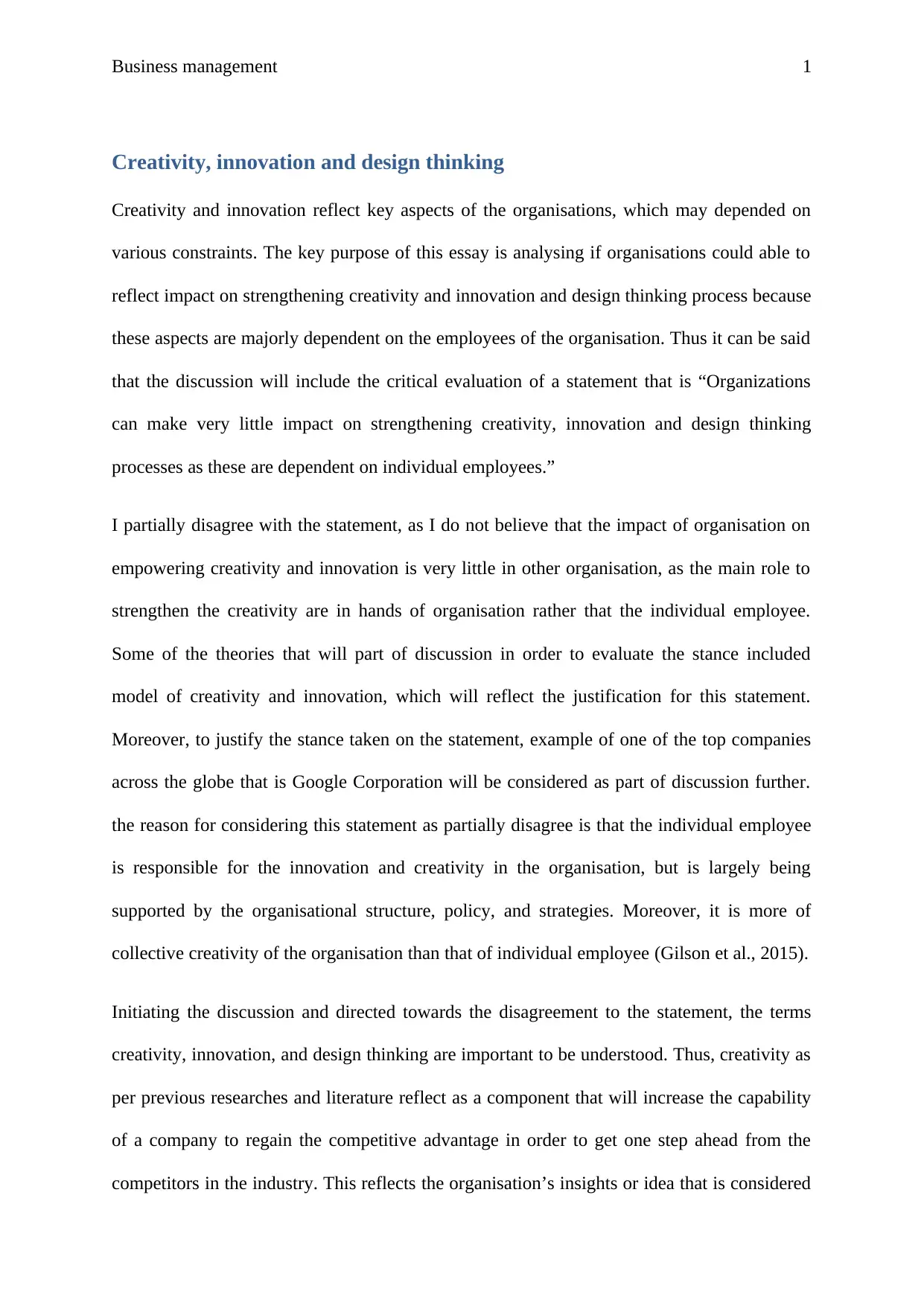
Business management 1
Creativity, innovation and design thinking
Creativity and innovation reflect key aspects of the organisations, which may depended on
various constraints. The key purpose of this essay is analysing if organisations could able to
reflect impact on strengthening creativity and innovation and design thinking process because
these aspects are majorly dependent on the employees of the organisation. Thus it can be said
that the discussion will include the critical evaluation of a statement that is “Organizations
can make very little impact on strengthening creativity, innovation and design thinking
processes as these are dependent on individual employees.”
I partially disagree with the statement, as I do not believe that the impact of organisation on
empowering creativity and innovation is very little in other organisation, as the main role to
strengthen the creativity are in hands of organisation rather that the individual employee.
Some of the theories that will part of discussion in order to evaluate the stance included
model of creativity and innovation, which will reflect the justification for this statement.
Moreover, to justify the stance taken on the statement, example of one of the top companies
across the globe that is Google Corporation will be considered as part of discussion further.
the reason for considering this statement as partially disagree is that the individual employee
is responsible for the innovation and creativity in the organisation, but is largely being
supported by the organisational structure, policy, and strategies. Moreover, it is more of
collective creativity of the organisation than that of individual employee (Gilson et al., 2015).
Initiating the discussion and directed towards the disagreement to the statement, the terms
creativity, innovation, and design thinking are important to be understood. Thus, creativity as
per previous researches and literature reflect as a component that will increase the capability
of a company to regain the competitive advantage in order to get one step ahead from the
competitors in the industry. This reflects the organisation’s insights or idea that is considered
Creativity, innovation and design thinking
Creativity and innovation reflect key aspects of the organisations, which may depended on
various constraints. The key purpose of this essay is analysing if organisations could able to
reflect impact on strengthening creativity and innovation and design thinking process because
these aspects are majorly dependent on the employees of the organisation. Thus it can be said
that the discussion will include the critical evaluation of a statement that is “Organizations
can make very little impact on strengthening creativity, innovation and design thinking
processes as these are dependent on individual employees.”
I partially disagree with the statement, as I do not believe that the impact of organisation on
empowering creativity and innovation is very little in other organisation, as the main role to
strengthen the creativity are in hands of organisation rather that the individual employee.
Some of the theories that will part of discussion in order to evaluate the stance included
model of creativity and innovation, which will reflect the justification for this statement.
Moreover, to justify the stance taken on the statement, example of one of the top companies
across the globe that is Google Corporation will be considered as part of discussion further.
the reason for considering this statement as partially disagree is that the individual employee
is responsible for the innovation and creativity in the organisation, but is largely being
supported by the organisational structure, policy, and strategies. Moreover, it is more of
collective creativity of the organisation than that of individual employee (Gilson et al., 2015).
Initiating the discussion and directed towards the disagreement to the statement, the terms
creativity, innovation, and design thinking are important to be understood. Thus, creativity as
per previous researches and literature reflect as a component that will increase the capability
of a company to regain the competitive advantage in order to get one step ahead from the
competitors in the industry. This reflects the organisation’s insights or idea that is considered
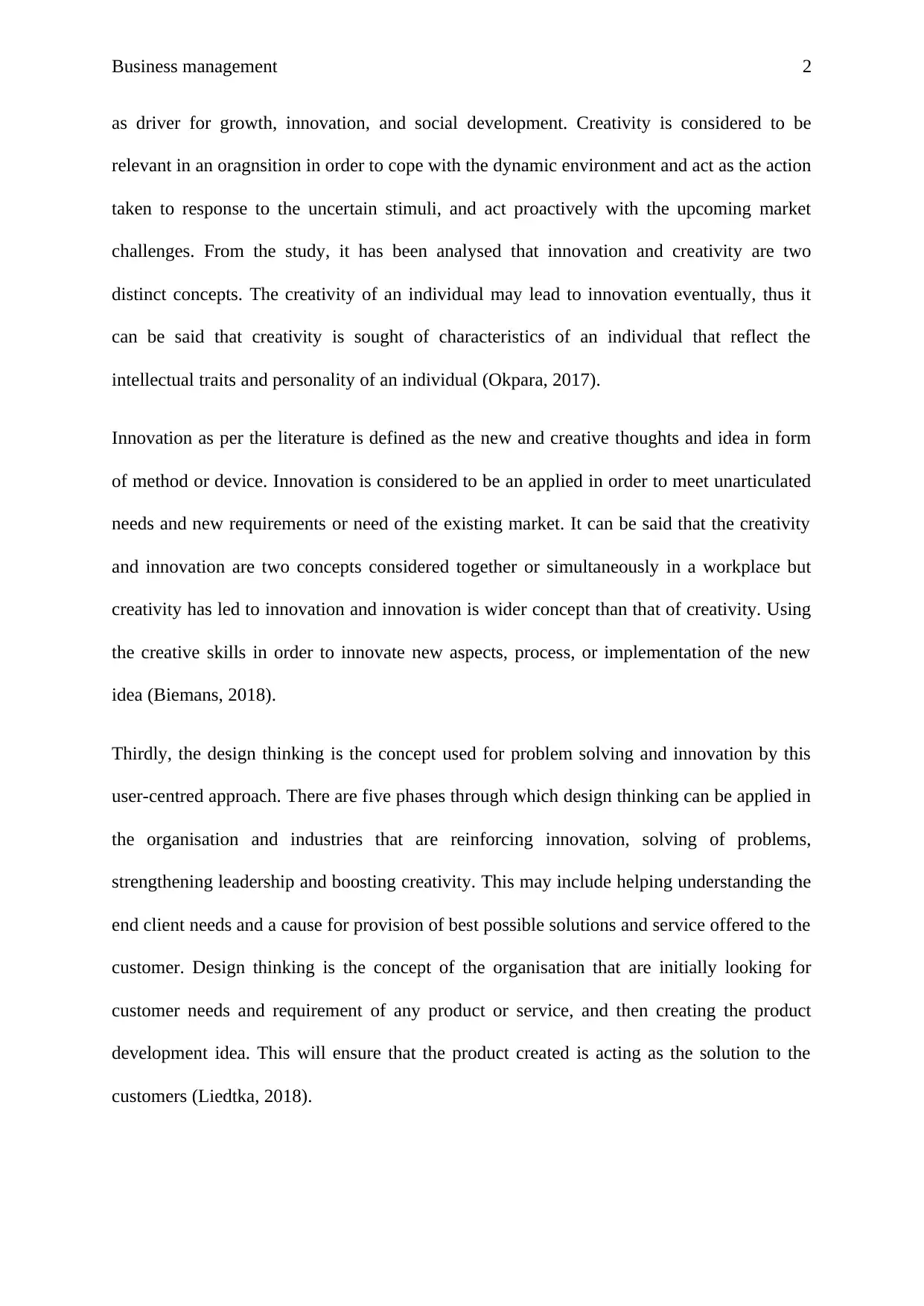
Business management 2
as driver for growth, innovation, and social development. Creativity is considered to be
relevant in an oragnsition in order to cope with the dynamic environment and act as the action
taken to response to the uncertain stimuli, and act proactively with the upcoming market
challenges. From the study, it has been analysed that innovation and creativity are two
distinct concepts. The creativity of an individual may lead to innovation eventually, thus it
can be said that creativity is sought of characteristics of an individual that reflect the
intellectual traits and personality of an individual (Okpara, 2017).
Innovation as per the literature is defined as the new and creative thoughts and idea in form
of method or device. Innovation is considered to be an applied in order to meet unarticulated
needs and new requirements or need of the existing market. It can be said that the creativity
and innovation are two concepts considered together or simultaneously in a workplace but
creativity has led to innovation and innovation is wider concept than that of creativity. Using
the creative skills in order to innovate new aspects, process, or implementation of the new
idea (Biemans, 2018).
Thirdly, the design thinking is the concept used for problem solving and innovation by this
user-centred approach. There are five phases through which design thinking can be applied in
the organisation and industries that are reinforcing innovation, solving of problems,
strengthening leadership and boosting creativity. This may include helping understanding the
end client needs and a cause for provision of best possible solutions and service offered to the
customer. Design thinking is the concept of the organisation that are initially looking for
customer needs and requirement of any product or service, and then creating the product
development idea. This will ensure that the product created is acting as the solution to the
customers (Liedtka, 2018).
as driver for growth, innovation, and social development. Creativity is considered to be
relevant in an oragnsition in order to cope with the dynamic environment and act as the action
taken to response to the uncertain stimuli, and act proactively with the upcoming market
challenges. From the study, it has been analysed that innovation and creativity are two
distinct concepts. The creativity of an individual may lead to innovation eventually, thus it
can be said that creativity is sought of characteristics of an individual that reflect the
intellectual traits and personality of an individual (Okpara, 2017).
Innovation as per the literature is defined as the new and creative thoughts and idea in form
of method or device. Innovation is considered to be an applied in order to meet unarticulated
needs and new requirements or need of the existing market. It can be said that the creativity
and innovation are two concepts considered together or simultaneously in a workplace but
creativity has led to innovation and innovation is wider concept than that of creativity. Using
the creative skills in order to innovate new aspects, process, or implementation of the new
idea (Biemans, 2018).
Thirdly, the design thinking is the concept used for problem solving and innovation by this
user-centred approach. There are five phases through which design thinking can be applied in
the organisation and industries that are reinforcing innovation, solving of problems,
strengthening leadership and boosting creativity. This may include helping understanding the
end client needs and a cause for provision of best possible solutions and service offered to the
customer. Design thinking is the concept of the organisation that are initially looking for
customer needs and requirement of any product or service, and then creating the product
development idea. This will ensure that the product created is acting as the solution to the
customers (Liedtka, 2018).
⊘ This is a preview!⊘
Do you want full access?
Subscribe today to unlock all pages.

Trusted by 1+ million students worldwide
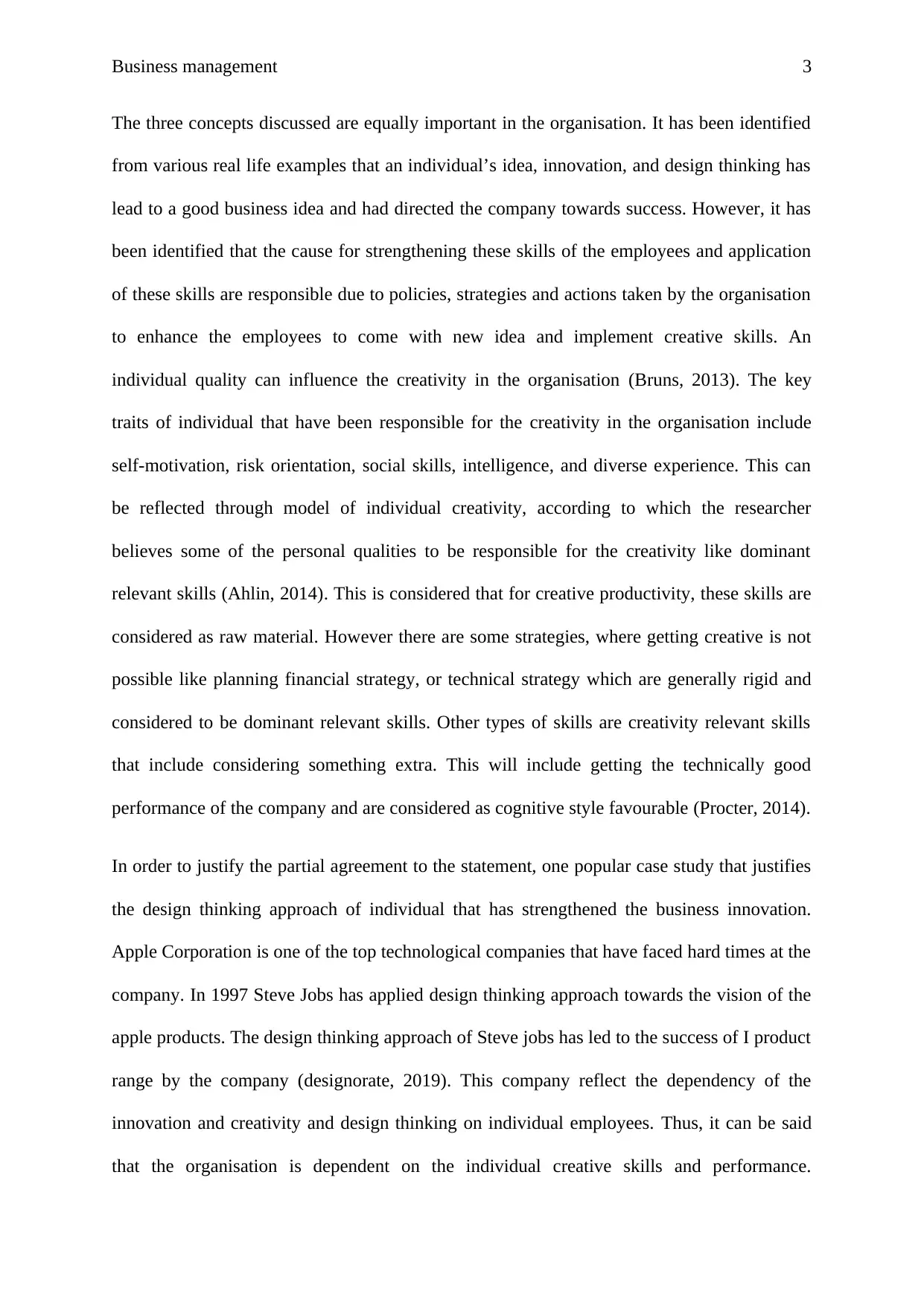
Business management 3
The three concepts discussed are equally important in the organisation. It has been identified
from various real life examples that an individual’s idea, innovation, and design thinking has
lead to a good business idea and had directed the company towards success. However, it has
been identified that the cause for strengthening these skills of the employees and application
of these skills are responsible due to policies, strategies and actions taken by the organisation
to enhance the employees to come with new idea and implement creative skills. An
individual quality can influence the creativity in the organisation (Bruns, 2013). The key
traits of individual that have been responsible for the creativity in the organisation include
self-motivation, risk orientation, social skills, intelligence, and diverse experience. This can
be reflected through model of individual creativity, according to which the researcher
believes some of the personal qualities to be responsible for the creativity like dominant
relevant skills (Ahlin, 2014). This is considered that for creative productivity, these skills are
considered as raw material. However there are some strategies, where getting creative is not
possible like planning financial strategy, or technical strategy which are generally rigid and
considered to be dominant relevant skills. Other types of skills are creativity relevant skills
that include considering something extra. This will include getting the technically good
performance of the company and are considered as cognitive style favourable (Procter, 2014).
In order to justify the partial agreement to the statement, one popular case study that justifies
the design thinking approach of individual that has strengthened the business innovation.
Apple Corporation is one of the top technological companies that have faced hard times at the
company. In 1997 Steve Jobs has applied design thinking approach towards the vision of the
apple products. The design thinking approach of Steve jobs has led to the success of I product
range by the company (designorate, 2019). This company reflect the dependency of the
innovation and creativity and design thinking on individual employees. Thus, it can be said
that the organisation is dependent on the individual creative skills and performance.
The three concepts discussed are equally important in the organisation. It has been identified
from various real life examples that an individual’s idea, innovation, and design thinking has
lead to a good business idea and had directed the company towards success. However, it has
been identified that the cause for strengthening these skills of the employees and application
of these skills are responsible due to policies, strategies and actions taken by the organisation
to enhance the employees to come with new idea and implement creative skills. An
individual quality can influence the creativity in the organisation (Bruns, 2013). The key
traits of individual that have been responsible for the creativity in the organisation include
self-motivation, risk orientation, social skills, intelligence, and diverse experience. This can
be reflected through model of individual creativity, according to which the researcher
believes some of the personal qualities to be responsible for the creativity like dominant
relevant skills (Ahlin, 2014). This is considered that for creative productivity, these skills are
considered as raw material. However there are some strategies, where getting creative is not
possible like planning financial strategy, or technical strategy which are generally rigid and
considered to be dominant relevant skills. Other types of skills are creativity relevant skills
that include considering something extra. This will include getting the technically good
performance of the company and are considered as cognitive style favourable (Procter, 2014).
In order to justify the partial agreement to the statement, one popular case study that justifies
the design thinking approach of individual that has strengthened the business innovation.
Apple Corporation is one of the top technological companies that have faced hard times at the
company. In 1997 Steve Jobs has applied design thinking approach towards the vision of the
apple products. The design thinking approach of Steve jobs has led to the success of I product
range by the company (designorate, 2019). This company reflect the dependency of the
innovation and creativity and design thinking on individual employees. Thus, it can be said
that the organisation is dependent on the individual creative skills and performance.
Paraphrase This Document
Need a fresh take? Get an instant paraphrase of this document with our AI Paraphraser
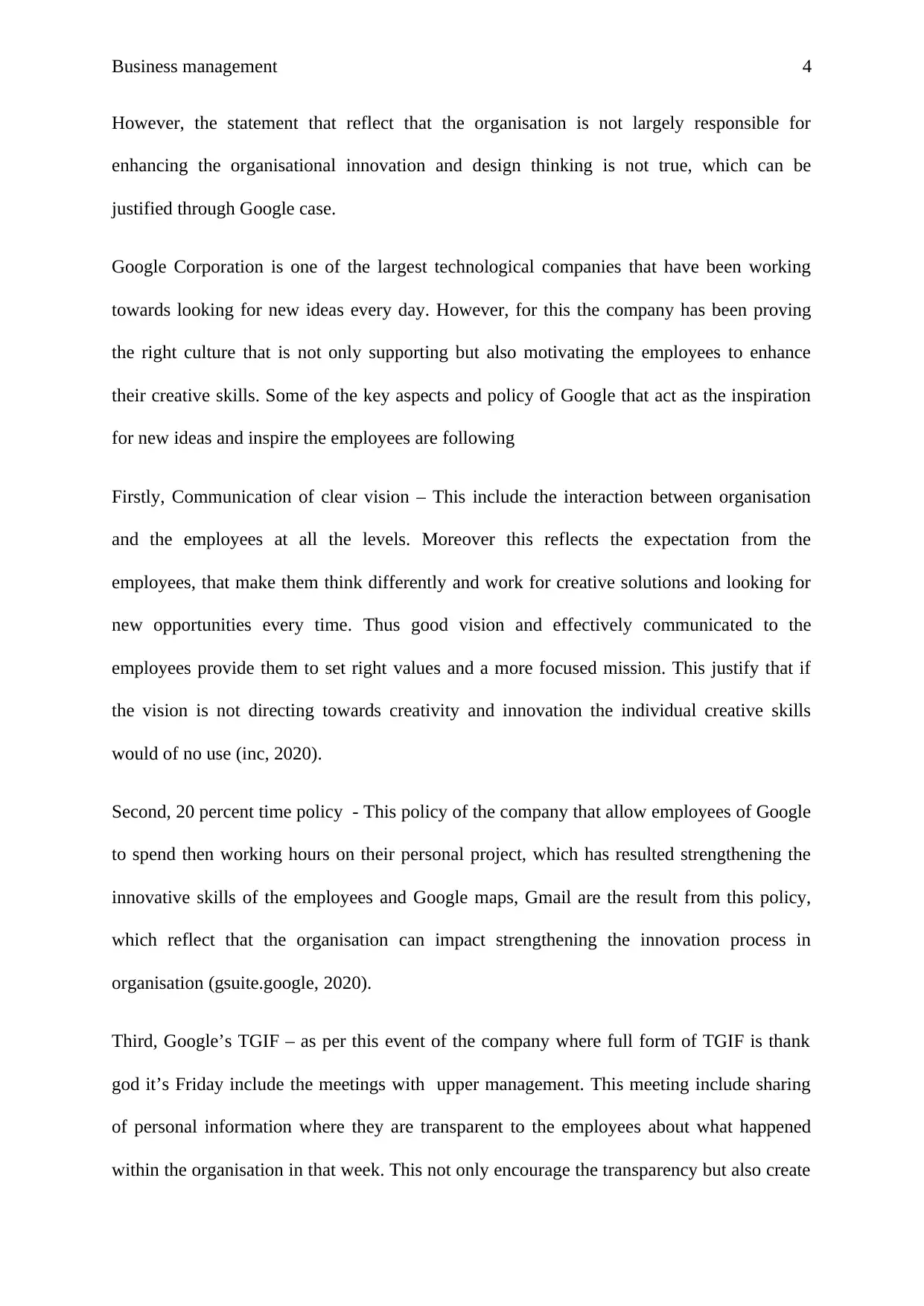
Business management 4
However, the statement that reflect that the organisation is not largely responsible for
enhancing the organisational innovation and design thinking is not true, which can be
justified through Google case.
Google Corporation is one of the largest technological companies that have been working
towards looking for new ideas every day. However, for this the company has been proving
the right culture that is not only supporting but also motivating the employees to enhance
their creative skills. Some of the key aspects and policy of Google that act as the inspiration
for new ideas and inspire the employees are following
Firstly, Communication of clear vision – This include the interaction between organisation
and the employees at all the levels. Moreover this reflects the expectation from the
employees, that make them think differently and work for creative solutions and looking for
new opportunities every time. Thus good vision and effectively communicated to the
employees provide them to set right values and a more focused mission. This justify that if
the vision is not directing towards creativity and innovation the individual creative skills
would of no use (inc, 2020).
Second, 20 percent time policy - This policy of the company that allow employees of Google
to spend then working hours on their personal project, which has resulted strengthening the
innovative skills of the employees and Google maps, Gmail are the result from this policy,
which reflect that the organisation can impact strengthening the innovation process in
organisation (gsuite.google, 2020).
Third, Google’s TGIF – as per this event of the company where full form of TGIF is thank
god it’s Friday include the meetings with upper management. This meeting include sharing
of personal information where they are transparent to the employees about what happened
within the organisation in that week. This not only encourage the transparency but also create
However, the statement that reflect that the organisation is not largely responsible for
enhancing the organisational innovation and design thinking is not true, which can be
justified through Google case.
Google Corporation is one of the largest technological companies that have been working
towards looking for new ideas every day. However, for this the company has been proving
the right culture that is not only supporting but also motivating the employees to enhance
their creative skills. Some of the key aspects and policy of Google that act as the inspiration
for new ideas and inspire the employees are following
Firstly, Communication of clear vision – This include the interaction between organisation
and the employees at all the levels. Moreover this reflects the expectation from the
employees, that make them think differently and work for creative solutions and looking for
new opportunities every time. Thus good vision and effectively communicated to the
employees provide them to set right values and a more focused mission. This justify that if
the vision is not directing towards creativity and innovation the individual creative skills
would of no use (inc, 2020).
Second, 20 percent time policy - This policy of the company that allow employees of Google
to spend then working hours on their personal project, which has resulted strengthening the
innovative skills of the employees and Google maps, Gmail are the result from this policy,
which reflect that the organisation can impact strengthening the innovation process in
organisation (gsuite.google, 2020).
Third, Google’s TGIF – as per this event of the company where full form of TGIF is thank
god it’s Friday include the meetings with upper management. This meeting include sharing
of personal information where they are transparent to the employees about what happened
within the organisation in that week. This not only encourage the transparency but also create
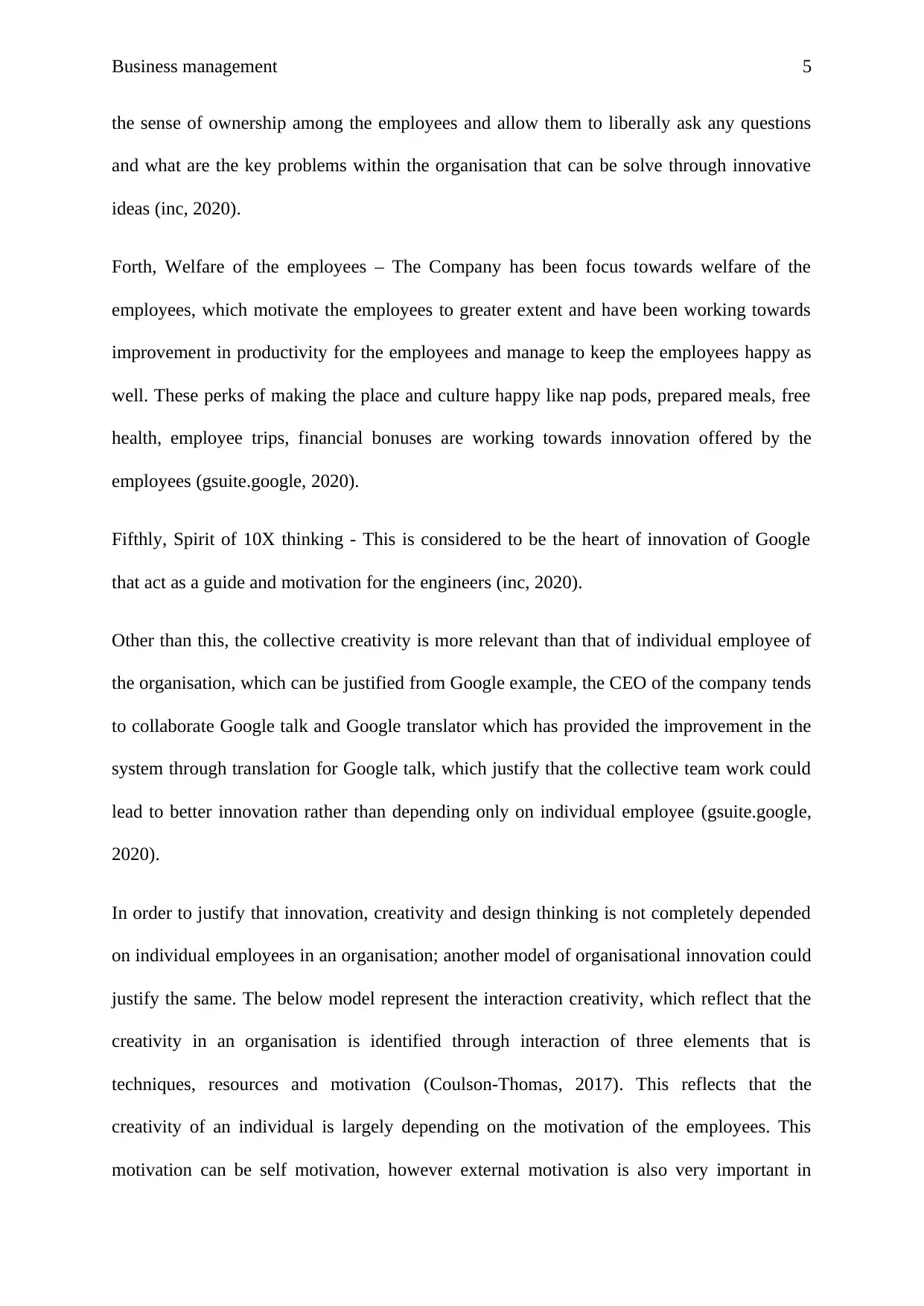
Business management 5
the sense of ownership among the employees and allow them to liberally ask any questions
and what are the key problems within the organisation that can be solve through innovative
ideas (inc, 2020).
Forth, Welfare of the employees – The Company has been focus towards welfare of the
employees, which motivate the employees to greater extent and have been working towards
improvement in productivity for the employees and manage to keep the employees happy as
well. These perks of making the place and culture happy like nap pods, prepared meals, free
health, employee trips, financial bonuses are working towards innovation offered by the
employees (gsuite.google, 2020).
Fifthly, Spirit of 10X thinking - This is considered to be the heart of innovation of Google
that act as a guide and motivation for the engineers (inc, 2020).
Other than this, the collective creativity is more relevant than that of individual employee of
the organisation, which can be justified from Google example, the CEO of the company tends
to collaborate Google talk and Google translator which has provided the improvement in the
system through translation for Google talk, which justify that the collective team work could
lead to better innovation rather than depending only on individual employee (gsuite.google,
2020).
In order to justify that innovation, creativity and design thinking is not completely depended
on individual employees in an organisation; another model of organisational innovation could
justify the same. The below model represent the interaction creativity, which reflect that the
creativity in an organisation is identified through interaction of three elements that is
techniques, resources and motivation (Coulson-Thomas, 2017). This reflects that the
creativity of an individual is largely depending on the motivation of the employees. This
motivation can be self motivation, however external motivation is also very important in
the sense of ownership among the employees and allow them to liberally ask any questions
and what are the key problems within the organisation that can be solve through innovative
ideas (inc, 2020).
Forth, Welfare of the employees – The Company has been focus towards welfare of the
employees, which motivate the employees to greater extent and have been working towards
improvement in productivity for the employees and manage to keep the employees happy as
well. These perks of making the place and culture happy like nap pods, prepared meals, free
health, employee trips, financial bonuses are working towards innovation offered by the
employees (gsuite.google, 2020).
Fifthly, Spirit of 10X thinking - This is considered to be the heart of innovation of Google
that act as a guide and motivation for the engineers (inc, 2020).
Other than this, the collective creativity is more relevant than that of individual employee of
the organisation, which can be justified from Google example, the CEO of the company tends
to collaborate Google talk and Google translator which has provided the improvement in the
system through translation for Google talk, which justify that the collective team work could
lead to better innovation rather than depending only on individual employee (gsuite.google,
2020).
In order to justify that innovation, creativity and design thinking is not completely depended
on individual employees in an organisation; another model of organisational innovation could
justify the same. The below model represent the interaction creativity, which reflect that the
creativity in an organisation is identified through interaction of three elements that is
techniques, resources and motivation (Coulson-Thomas, 2017). This reflects that the
creativity of an individual is largely depending on the motivation of the employees. This
motivation can be self motivation, however external motivation is also very important in
⊘ This is a preview!⊘
Do you want full access?
Subscribe today to unlock all pages.

Trusted by 1+ million students worldwide
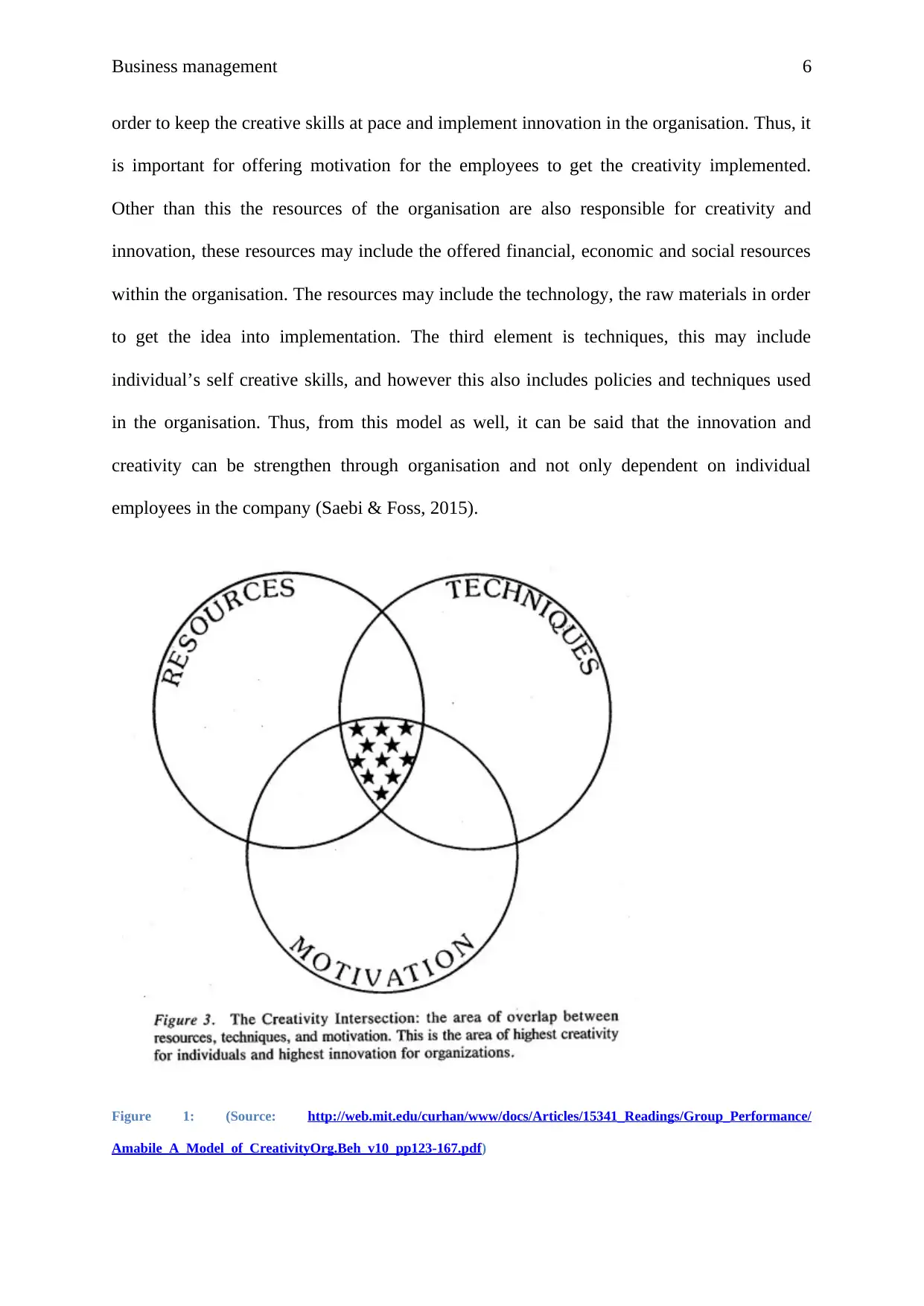
Business management 6
order to keep the creative skills at pace and implement innovation in the organisation. Thus, it
is important for offering motivation for the employees to get the creativity implemented.
Other than this the resources of the organisation are also responsible for creativity and
innovation, these resources may include the offered financial, economic and social resources
within the organisation. The resources may include the technology, the raw materials in order
to get the idea into implementation. The third element is techniques, this may include
individual’s self creative skills, and however this also includes policies and techniques used
in the organisation. Thus, from this model as well, it can be said that the innovation and
creativity can be strengthen through organisation and not only dependent on individual
employees in the company (Saebi & Foss, 2015).
Figure 1: (Source: http://web.mit.edu/curhan/www/docs/Articles/15341_Readings/Group_Performance/
Amabile_A_Model_of_CreativityOrg.Beh_v10_pp123-167.pdf)
order to keep the creative skills at pace and implement innovation in the organisation. Thus, it
is important for offering motivation for the employees to get the creativity implemented.
Other than this the resources of the organisation are also responsible for creativity and
innovation, these resources may include the offered financial, economic and social resources
within the organisation. The resources may include the technology, the raw materials in order
to get the idea into implementation. The third element is techniques, this may include
individual’s self creative skills, and however this also includes policies and techniques used
in the organisation. Thus, from this model as well, it can be said that the innovation and
creativity can be strengthen through organisation and not only dependent on individual
employees in the company (Saebi & Foss, 2015).
Figure 1: (Source: http://web.mit.edu/curhan/www/docs/Articles/15341_Readings/Group_Performance/
Amabile_A_Model_of_CreativityOrg.Beh_v10_pp123-167.pdf)
Paraphrase This Document
Need a fresh take? Get an instant paraphrase of this document with our AI Paraphraser
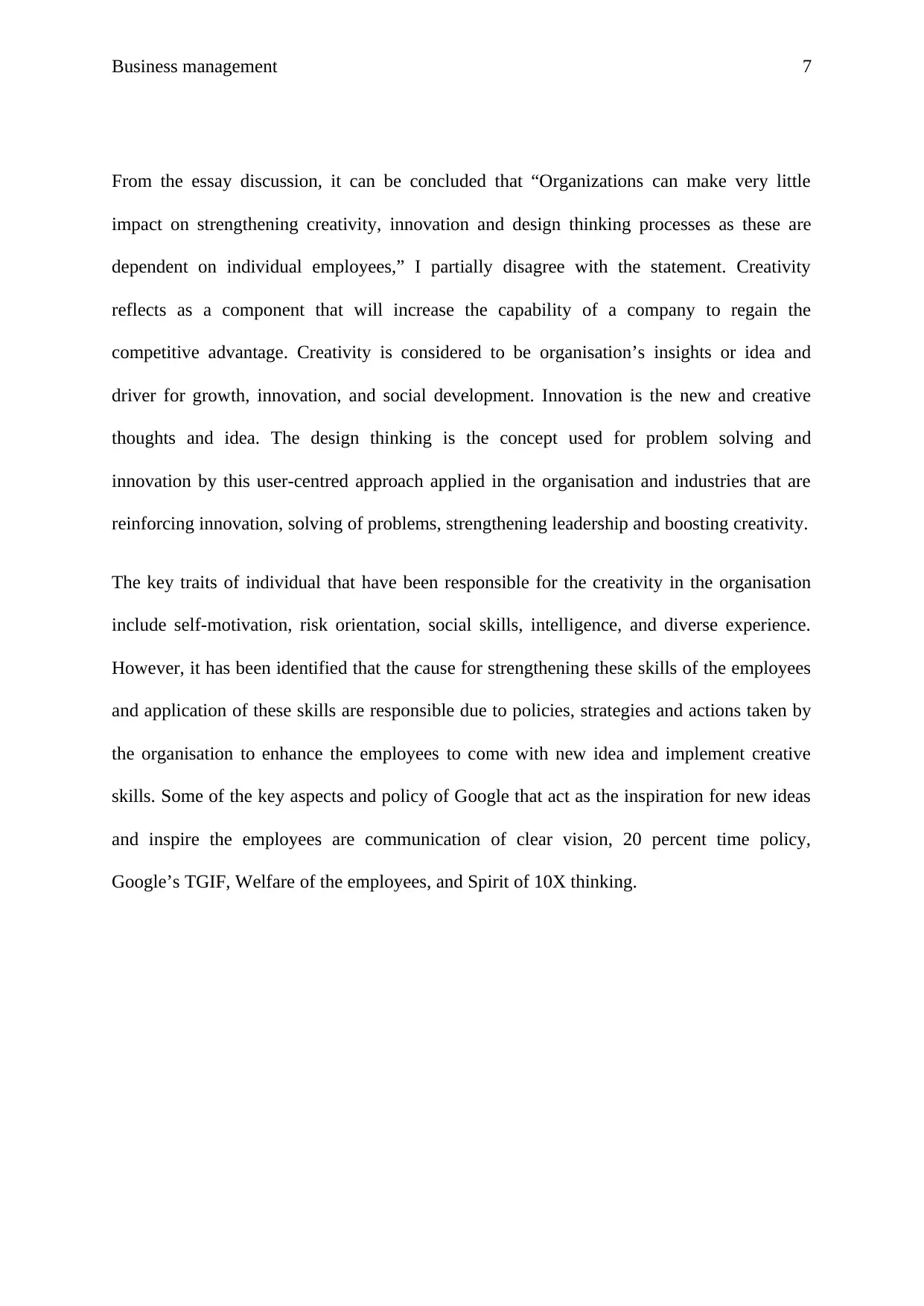
Business management 7
From the essay discussion, it can be concluded that “Organizations can make very little
impact on strengthening creativity, innovation and design thinking processes as these are
dependent on individual employees,” I partially disagree with the statement. Creativity
reflects as a component that will increase the capability of a company to regain the
competitive advantage. Creativity is considered to be organisation’s insights or idea and
driver for growth, innovation, and social development. Innovation is the new and creative
thoughts and idea. The design thinking is the concept used for problem solving and
innovation by this user-centred approach applied in the organisation and industries that are
reinforcing innovation, solving of problems, strengthening leadership and boosting creativity.
The key traits of individual that have been responsible for the creativity in the organisation
include self-motivation, risk orientation, social skills, intelligence, and diverse experience.
However, it has been identified that the cause for strengthening these skills of the employees
and application of these skills are responsible due to policies, strategies and actions taken by
the organisation to enhance the employees to come with new idea and implement creative
skills. Some of the key aspects and policy of Google that act as the inspiration for new ideas
and inspire the employees are communication of clear vision, 20 percent time policy,
Google’s TGIF, Welfare of the employees, and Spirit of 10X thinking.
From the essay discussion, it can be concluded that “Organizations can make very little
impact on strengthening creativity, innovation and design thinking processes as these are
dependent on individual employees,” I partially disagree with the statement. Creativity
reflects as a component that will increase the capability of a company to regain the
competitive advantage. Creativity is considered to be organisation’s insights or idea and
driver for growth, innovation, and social development. Innovation is the new and creative
thoughts and idea. The design thinking is the concept used for problem solving and
innovation by this user-centred approach applied in the organisation and industries that are
reinforcing innovation, solving of problems, strengthening leadership and boosting creativity.
The key traits of individual that have been responsible for the creativity in the organisation
include self-motivation, risk orientation, social skills, intelligence, and diverse experience.
However, it has been identified that the cause for strengthening these skills of the employees
and application of these skills are responsible due to policies, strategies and actions taken by
the organisation to enhance the employees to come with new idea and implement creative
skills. Some of the key aspects and policy of Google that act as the inspiration for new ideas
and inspire the employees are communication of clear vision, 20 percent time policy,
Google’s TGIF, Welfare of the employees, and Spirit of 10X thinking.
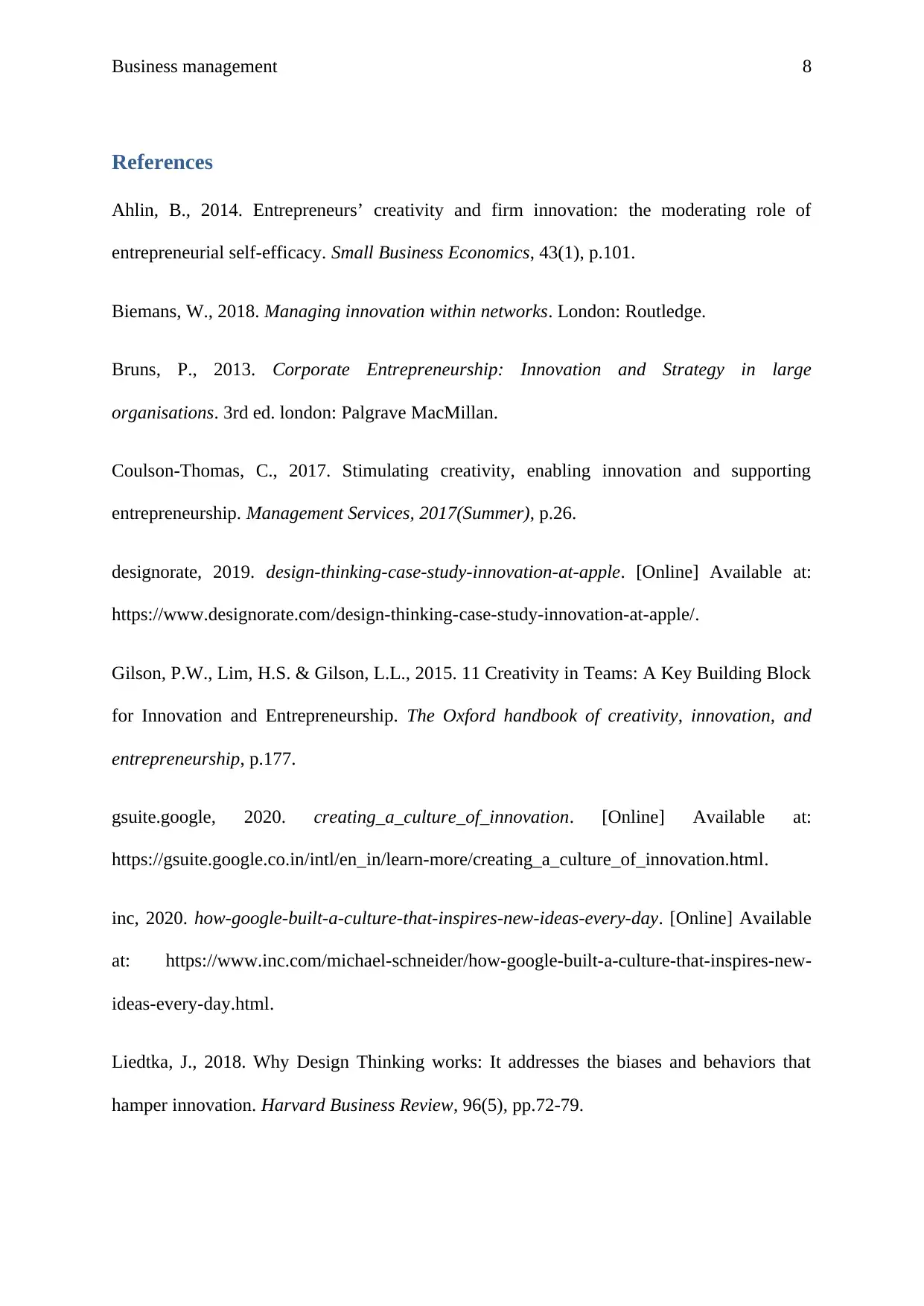
Business management 8
References
Ahlin, B., 2014. Entrepreneurs’ creativity and firm innovation: the moderating role of
entrepreneurial self-efficacy. Small Business Economics, 43(1), p.101.
Biemans, W., 2018. Managing innovation within networks. London: Routledge.
Bruns, P., 2013. Corporate Entrepreneurship: Innovation and Strategy in large
organisations. 3rd ed. london: Palgrave MacMillan.
Coulson-Thomas, C., 2017. Stimulating creativity, enabling innovation and supporting
entrepreneurship. Management Services, 2017(Summer), p.26.
designorate, 2019. design-thinking-case-study-innovation-at-apple. [Online] Available at:
https://www.designorate.com/design-thinking-case-study-innovation-at-apple/.
Gilson, P.W., Lim, H.S. & Gilson, L.L., 2015. 11 Creativity in Teams: A Key Building Block
for Innovation and Entrepreneurship. The Oxford handbook of creativity, innovation, and
entrepreneurship, p.177.
gsuite.google, 2020. creating_a_culture_of_innovation. [Online] Available at:
https://gsuite.google.co.in/intl/en_in/learn-more/creating_a_culture_of_innovation.html.
inc, 2020. how-google-built-a-culture-that-inspires-new-ideas-every-day. [Online] Available
at: https://www.inc.com/michael-schneider/how-google-built-a-culture-that-inspires-new-
ideas-every-day.html.
Liedtka, J., 2018. Why Design Thinking works: It addresses the biases and behaviors that
hamper innovation. Harvard Business Review, 96(5), pp.72-79.
References
Ahlin, B., 2014. Entrepreneurs’ creativity and firm innovation: the moderating role of
entrepreneurial self-efficacy. Small Business Economics, 43(1), p.101.
Biemans, W., 2018. Managing innovation within networks. London: Routledge.
Bruns, P., 2013. Corporate Entrepreneurship: Innovation and Strategy in large
organisations. 3rd ed. london: Palgrave MacMillan.
Coulson-Thomas, C., 2017. Stimulating creativity, enabling innovation and supporting
entrepreneurship. Management Services, 2017(Summer), p.26.
designorate, 2019. design-thinking-case-study-innovation-at-apple. [Online] Available at:
https://www.designorate.com/design-thinking-case-study-innovation-at-apple/.
Gilson, P.W., Lim, H.S. & Gilson, L.L., 2015. 11 Creativity in Teams: A Key Building Block
for Innovation and Entrepreneurship. The Oxford handbook of creativity, innovation, and
entrepreneurship, p.177.
gsuite.google, 2020. creating_a_culture_of_innovation. [Online] Available at:
https://gsuite.google.co.in/intl/en_in/learn-more/creating_a_culture_of_innovation.html.
inc, 2020. how-google-built-a-culture-that-inspires-new-ideas-every-day. [Online] Available
at: https://www.inc.com/michael-schneider/how-google-built-a-culture-that-inspires-new-
ideas-every-day.html.
Liedtka, J., 2018. Why Design Thinking works: It addresses the biases and behaviors that
hamper innovation. Harvard Business Review, 96(5), pp.72-79.
⊘ This is a preview!⊘
Do you want full access?
Subscribe today to unlock all pages.

Trusted by 1+ million students worldwide
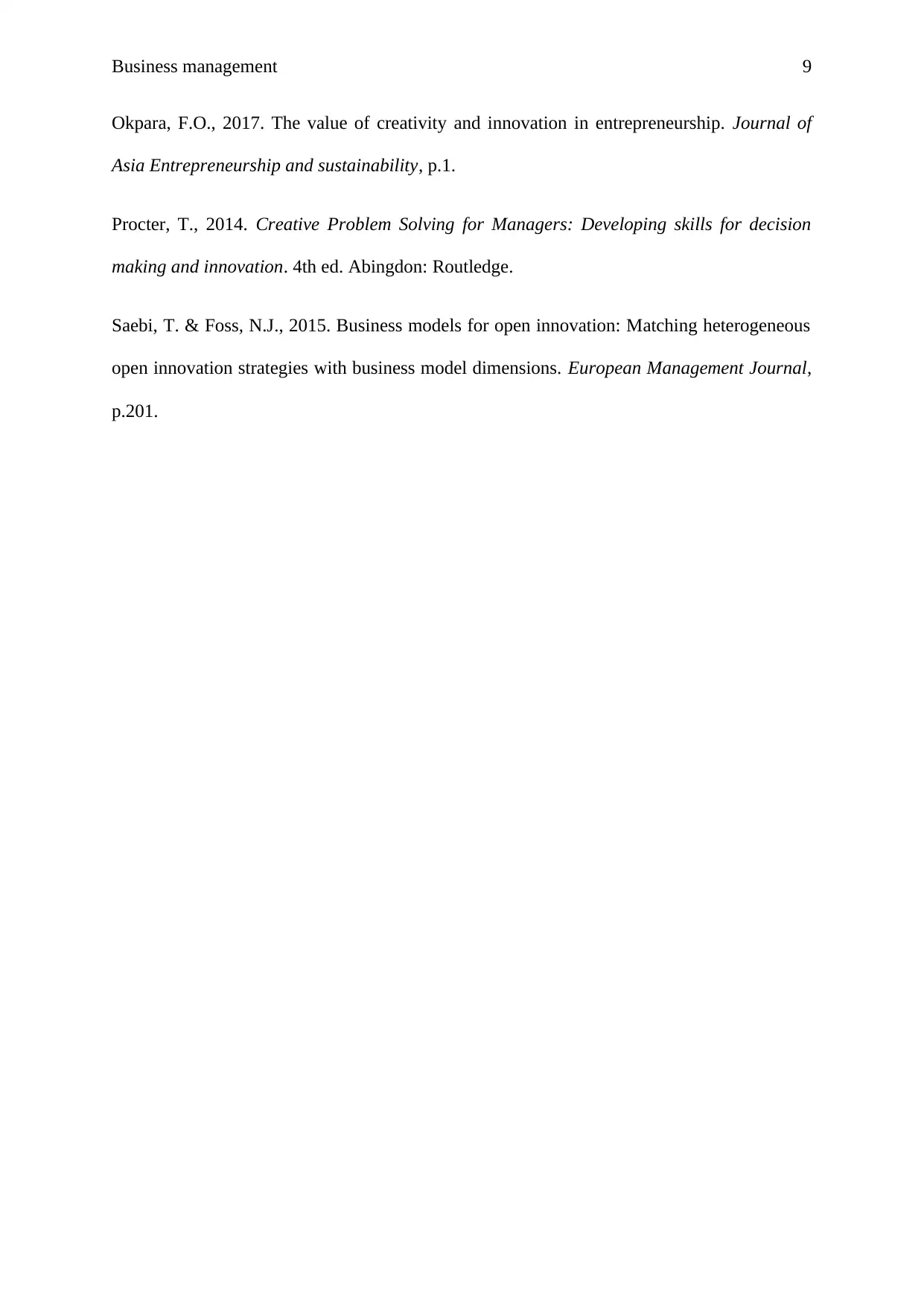
Business management 9
Okpara, F.O., 2017. The value of creativity and innovation in entrepreneurship. Journal of
Asia Entrepreneurship and sustainability, p.1.
Procter, T., 2014. Creative Problem Solving for Managers: Developing skills for decision
making and innovation. 4th ed. Abingdon: Routledge.
Saebi, T. & Foss, N.J., 2015. Business models for open innovation: Matching heterogeneous
open innovation strategies with business model dimensions. European Management Journal,
p.201.
Okpara, F.O., 2017. The value of creativity and innovation in entrepreneurship. Journal of
Asia Entrepreneurship and sustainability, p.1.
Procter, T., 2014. Creative Problem Solving for Managers: Developing skills for decision
making and innovation. 4th ed. Abingdon: Routledge.
Saebi, T. & Foss, N.J., 2015. Business models for open innovation: Matching heterogeneous
open innovation strategies with business model dimensions. European Management Journal,
p.201.
1 out of 10
Related Documents
Your All-in-One AI-Powered Toolkit for Academic Success.
+13062052269
info@desklib.com
Available 24*7 on WhatsApp / Email
![[object Object]](/_next/static/media/star-bottom.7253800d.svg)
Unlock your academic potential
Copyright © 2020–2025 A2Z Services. All Rights Reserved. Developed and managed by ZUCOL.





